June 29 - July 5, 2014: Issue 169
Chief Joseph and Edward S Curtis; His Remarkable Images of Native Americans – an Inestimable Record of Images and Portrait Photographs
Homeward - Edward s. Curtis, 1898 - Orotone print from original. Curtis Studio label affixed to an original Curtis Studio frame, 8 x 10in. (20.3 x 25.4cm.). Sold for $3055.00 US in April 2000.
Chief Joseph and Edward S Curtis; His Remarkable Images of Native Americans, an Inestimable Record of Images and Portrait Photographs
“Good pictures are not products of chance, but come from long hours of study.” Edward Curtis.
To many of us the multiculturalism of Australia is a rich and varied opportunity to gain insights into the cultures of others. Foods, dress, customs and even faces are celebrated for the emotions they express from joy to dignity. There are many predecessors who have clearly felt the same way and one of these sought to document and photograph the Native American peoples. That man was Edward Sheriff Curtis (February 16, 1868 – October 19, 1952) an ethnologist (a science that deals with the division of human beings into races and their origin, distribution, relations, and characteristics) and photographer of the American West and of Native American peoples.
Although he did not profit from this work, working to raise funds to continue as an assistant cameraman for Cecil B. DeMille and as an uncredited assistant cameraman in the 1923 filming of The Ten Commandments, selling the rights to his ethnographic motion picture In the Land of the Head-Hunters in 1924 to the American Museum of Natural History (paid $1,500 for the master print and the original camera negative, which had cost him over $20,000 to film – some sources stating the actual cost was much higher) and many descry his work stating he manipulated some images, removing any western contrivances such as parasols, for many, including current Native American peoples who say he is has restored customs and rituals and even languages to them, these wonderful visions serve as a window into the original peoples of the Americas that would not exist without him having bothered and having been supported in his venture by such men as J P Morgan and President Theodore Roosevelt.
Recently an original photogravure from this collection fetched $8,125 at auction at Christie’s, New York (Portfolio plate no. 256 - 2008). In 2012 The North American Indian being a Series of Volumes Picturing and Describing the Indians of the United States and Alaska. Edited by Frederick Webb Hodge. Foreword by Theodore Roosevelt. Field Research conducted under the patronage of J. Pierpont Morgan. [Cambridge, Mass.], 1907-1930., 40 volumes: text in 20 volumes, (313 x 239 mm); Supplementary Large Plates in 20 portfolios, large folio (582 x 239 mm) a LIMITED EDITION, number 435 of 500 proposed sets (but probably only 272 sets produced), this copy on Japan vellum, volume one signed by Edward S. Curtis and dated 1907 went for $2,882,500.00 US.
This is a good reminder of how much Limited Edition books are worth, how much your own photographic work may be worth to future generations, and that you should never throw out old photos – the details of their subject matter, even what is in the background, has historical significance and although those taken by recognised photographers may cost more to avid collectors, each has it’s value in technique, style and many of these great old images are an art form in themselves. Another instance of this is a story our research found where someone had purchased a copy of one of these images by Mr. Curtis for $25.00 which turned out to be what is called an ‘authorised’ version and is actually worth $10,000 to $15,000 (2009 – Antiques Roadshow). This was a photographic portrait of Geronimo, which are rarer apparently. Others change hands for even more.
The other interesting aspect of these images and portraits is experts on his works state that Mr. Curtis also often framed them himself and these frames can add value to his ‘authorised’ versions. These wonderful images are still produced using Curtis' original glass plate negative and sell for thousands of dollars from dealers who can provide certifications of authenticity.
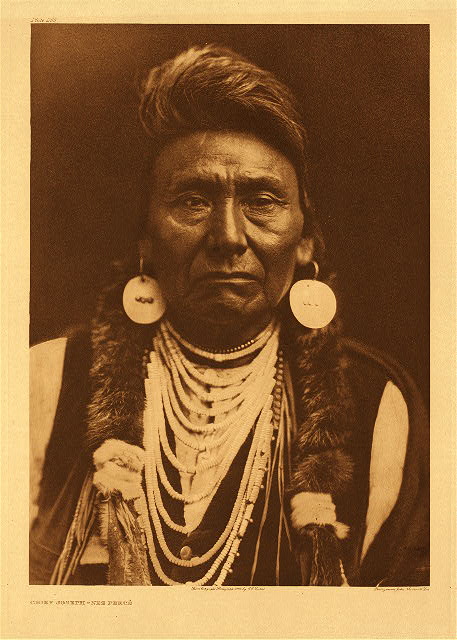 The portrait photograph that was bought for over eight thousand dollars was of Hin-mah-too-yah-lat-kekt, Hinmatóowyalahtq̓it in Americanist orthography(alternatively Hinmaton-Yalaktit or Hin-mah-too-yah-lat-kekt, Nez Perce: "Thunder Rolling Down the Mountain" or 'Hinmatóoyalahtq'it – “Thunder travelling to higher areas”), popularly known as Chief Joseph, or Young Joseph. In this picture Chief Joseph is wearing abalone shells – a symbol of nobility for these peoples.
The portrait photograph that was bought for over eight thousand dollars was of Hin-mah-too-yah-lat-kekt, Hinmatóowyalahtq̓it in Americanist orthography(alternatively Hinmaton-Yalaktit or Hin-mah-too-yah-lat-kekt, Nez Perce: "Thunder Rolling Down the Mountain" or 'Hinmatóoyalahtq'it – “Thunder travelling to higher areas”), popularly known as Chief Joseph, or Young Joseph. In this picture Chief Joseph is wearing abalone shells – a symbol of nobility for these peoples.
We have an avid collector of everything Native Americana and are fortunate to have a framed portrait print of this gentle man that visitors often comment on, asking ‘who is he?’.
Chief Joseph, or Young Joseph (March 3, 1840 – September 21, 1904), succeeded his father Tuekakas (Chief Joseph the Elder) as the leader of the Wal-lam-wat-kain (Wallowa) band of Nez Perce, a Native American tribe indigenous to the Wallowa Valley in northeastern Oregon. The Nez Perce ( Niimíipu) are a Native American people who live in the Pacific Northwest region (Columbia River Plateau) of the United States. According to many sources an anthropological interpretation says theses peoples descended from the Old Cordilleran Culture, which moved south from the Rocky Mountains and west into lands where the tribe coalesced. The federally recognized Nez Perce Nation currently governs and lives within its reservation in Idaho. Their name for themselves, ‘Nimíipuu’, means ‘The People’ in their language.
Chief Joseph is known due to his leading his people during the most tumultuous period in their contemporary history when he and his tribe were forcibly removed from their ancestral lands in the Wallowa Valley by the United States federal government onto a significantly reduced reservation in Lapwai, Idaho Territory. This series of events culminated in episodes of violence and led those Nez Perce who resisted removal, including Joseph's band and an allied band of the Palouse tribe, to take flight to attempt to reach political asylum, ultimately with the Sioux chief Sitting Bull in Canada.
They were pursued by the U.S. Army in a campaign led by General Oliver O. Howard. This 1,170-mile (1,900 km) fighting retreat by the Nez Perce in 1877 became known as the Nez Perce War. The skill with which the Nez Perce fought and the manner in which they conducted themselves in the face of incredible adversity led to widespread admiration among their military adversaries and the American public.
Coverage in United States newspapers led to widespread recognition of Joseph and the Nez Perce. For his principled resistance to the removal, he became renowned as a humanitarian and peacemaker. However, modern scholars like Robert McCoy and Thomas Guthrie state the coverage, as well as Joseph's speeches and writings, distorted the true nature of Joseph's thoughts and gave rise to a "mythical" Chief Joseph.
His exploits, with the coming of ships carrying news from England, America and elsewhere, appeared here months later, along with earlier insights into the conditions of those who were being dispossessed of their country, and homelands, by the masses seeking a new land and new life:
Washington, October 27-James M Cavanaugh arrived here on business connected with Indian affairs. Vincent Colyer, who has returned here, represents the Apaches of Arizona and New Mexico to be in a starving condition, and eager to accept offer of peace Coûte, Chief of the Apache Mohaves, was so reduced by starvation that he could not speak for several hours They complain against the whites taking possession of their country, whenever they wanted Government posts, they were hunted by scouts and shot. At Canada Alamaza, the Indians were invited and came in manifesting a friendly disposition He pronounces it untrue that depredations were committed at Camp Grant, or that he interfered with the movements of General Cook, Cochize and twenty warriors came on the Reservations at Canada Alamaza. He and the other Apache chiefs will visit Washington during the winter. AMERICA. (1871, December 14). The Maitland Mercury and Hunter River General Advertiser (NSW : 1843 - 1893), p. 4. Retrieved from http://nla.gov.au/nla.news-article18759624
AMERICA. The war with the Idaho Indians is still raging, and there have been more massacres. On the 10th July the Indian chief Joseph surprised a party of thirty-one Chinamen passing down the river Clearwater in boats, and slaughtered all but one. General Howard, who is in command of the State forces, encountered the Indians on the 12th July, driving them from a strong position, killing many, and pursuing them in the direction of Comas Pinino. Another skirmish took place the- following day. Howard is accused of messing the campaign.AMERICA. (1877, August 21). The Sydney Morning Herald(NSW : 1842 - 1954), p. 3. Retrieved from http://nla.gov.au/nla.news-article13398720
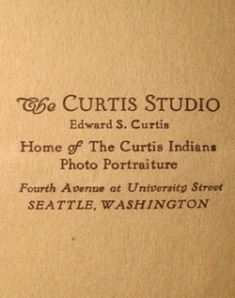 The Nez Perces (Indian) war has closed after a sharp fight. Chief Joseph surrendered. AMERICA. (1877, November 9). Illawarra Mercury (Wollongong, NSW : 1856 - 1950), p. 4. Retrieved fromhttp://nla.gov.au/nla.news-article135686399
The Nez Perces (Indian) war has closed after a sharp fight. Chief Joseph surrendered. AMERICA. (1877, November 9). Illawarra Mercury (Wollongong, NSW : 1856 - 1950), p. 4. Retrieved fromhttp://nla.gov.au/nla.news-article135686399
Chief Joseph was incarcerated far from his remaining tribe members. Although he had negotiated a safe return home for his people, General Sherman forced Joseph and four hundred followers to be taken on unheated rail cars to Fort Leavenworth in eastern Kansas to be held in a prisoner of war campsite for eight months. Toward the end of the following summer the surviving Nez Perce were taken by rail to a reservation in the Indian Territory (now Oklahoma) for seven years.Many of them died of epidemic diseases while there.
In 1879, Chief Joseph went to Washington, D.C. to meet with President Rutherford B. Hayes and plead the case of his people. Although Joseph was respected as a spokesman, opposition in Idaho prevented the U.S. government from granting his petition to return to the Pacific Northwest. Finally, in 1885, Chief Joseph and his followers were granted permission to return to the Pacific Northwest to settle on the reservation around Kooskia, Idaho. Instead, Joseph and others were taken to the Colville Indian Reservation far from both their homeland in the Wallowa Valley and the rest of their people in Idaho.
Joseph continued to lead his Wallowa band on the Colville Reservation, at times coming into conflict with the leaders of 11 other tribes living on the reservation. Chief Moses of the Sinkiuse-Columbia in particular resented having to cede a portion of his people's lands to Joseph's people, who had "made war on the Great Father."
In his last years Joseph spoke eloquently against the injustice of United States policy toward his people and held out the hope that America's promise of freedom and equality might one day be fulfilled for Native Americans as well. In 1897, he visited Washington again to plead his case. He rode in a parade honoring former President Ulysses Grant in New York City with Buffalo Bill Cody but he was a topic of conversation for his headdress more than his mission. - Wikipedia
In 1903, Chief Joseph visited Seattle, a booming young town, where he stayed in the Lincoln Hotel as guest to Edmond Meany, a history professor at the University of Washington. It was there that he also befriended Edward Curtis, the photographer, who took one of his most memorable and well-known photographs. He also visited President Theodore Roosevelt in Washington that year. Everywhere he went, it was to make a plea for what remained of his people to be returned to their home in the Wallowa Valley. But it would never happen. An indomitable voice of conscience for the West, he died in September 1904, still in exile from his homeland, according to his doctor "of a broken heart." Meany and Curtis would help his family bury their chief near the village of Nespelem.
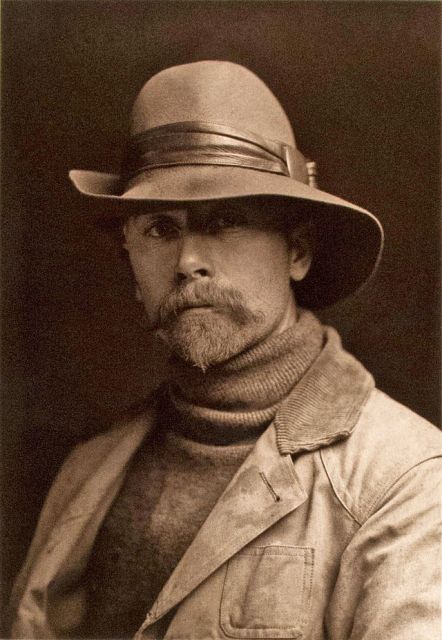 Edward Sheriff Curtis (February 16, 1868 – October 19, 1952), the man who spent over 30 years creating these images, became an apprentice photographer in St. Paul, Minnesota in 1885 at the age of 17. In 1887 he and his family moved to Seattle, Washington, where Edward purchased a new camera and became a partner in an existing photographic studio with Rasmus Rothi. Soon afterwards Curtis left Rothi and formed a new partnership with Thomas Guptill. The new studio was called Curtis and Guptill, Photographers and Photoengravers.
Edward Sheriff Curtis (February 16, 1868 – October 19, 1952), the man who spent over 30 years creating these images, became an apprentice photographer in St. Paul, Minnesota in 1885 at the age of 17. In 1887 he and his family moved to Seattle, Washington, where Edward purchased a new camera and became a partner in an existing photographic studio with Rasmus Rothi. Soon afterwards Curtis left Rothi and formed a new partnership with Thomas Guptill. The new studio was called Curtis and Guptill, Photographers and Photoengravers.
In 1895, Curtis met and photographed Princess Angeline (c. 1800–96), aka Kickisomlo, the daughter of Chief Sealth o fSeattle. This was to be his first portrait of a Native American. In 1898, three of Curtis' images were chosen for an exhibition sponsored by the National Photographic Society. Two were images of Princess Angeline, "The Mussel Gatherer", and "The Clam Digger". The other was of the Puget Sound, titled "Homeward" an image that was awarded the exhibition's grand prize and a gold medal.
_of_the_Duwamish,_1896.jpg?timestamp=1403826096599)
Right: 1889 self Portrait
Left: Kikisoblu - Princess Angeline - 1896
During that same year, while photographing Mt. Rainier, Curtis came upon a small group of scientists. Christie’s catalogue states of this 1898 encounter:
“…‘near tragedy dovetailed into good fortune when Curtis rescued several important naturalists and ethnologists from the peak of Mount Rainier: Gifford Pinchot, the Chief of the U.S. Division of Forestry, C. Hart Merriam, the Chief of the U.S. Division of Biological Survey, and George Bird Grinnell, an acknowledged expert on Plains Indians and then the editor of Forest & Stream. Within two years, Curtis was invited to accompany Grinnell to Montana to study the Blackfoot and Algonquin and the following year he accompanied Merriam on the historic Harriman expedition to Alaska.
In 1904, his portrait skills came to the attention of President Theodore Roosevelt, whose children Curtis photographed for "The Prettiest Children in America," a contest sponsored by the Ladies Home Journal. At the time of Roosevelt's second inaugural parade in 1906, Curtis took photographs of Geronimo and five other Indian chiefs on the White House lawn. Roosevelt was a loyal advocate of Curtis, and provided the Foreword to the first volume. In his Foreword, Roosevelt calls The North American Indian "a service not only to our people, but to the world of scholarship everywhere" (vol. I, p.ix).
Curtis's design to document every Indian tribe west of the Mississippi was logistically ambitious, not to mention financially daunting. In a letter to George Bird King, he wrote: "It's such a big dream, I can't see it all" (quoted in Sacred Legacy, p.19). Knowing of his need for financial support, Roosevelt introduced Curtis to J. Pierpont Morgan. Impressed with Curtis's work, the formidable financier offered $75,000 for a series on the North American Indian to contain 1,500 photographs in 20 volumes. Morgan was to receive 25 sets and 300 prints. Work began with the printing of the photogravures handled by John Andrew & Son and The Suffolk Engraving Company; the text was printed by The University Press in Cambridge and the Plimpton Press in Norwood, Mass.
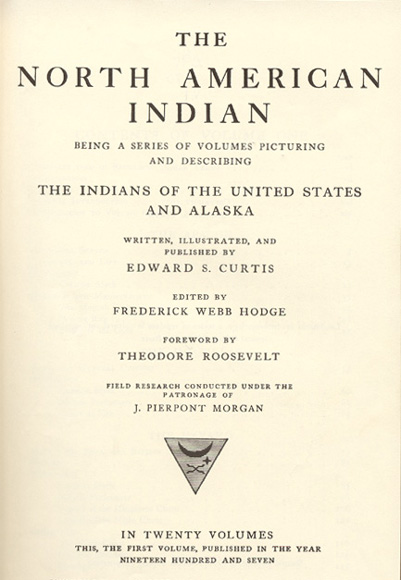 The first volume appeared in 1907 to a favorable review in The New York Herald, which called it "the most gigantic undertaking in the making of books since the King James edition of the Bible." Morgan died in 1913, just before the completion of the ninth volume. Curtis added a tribute to his benefactor, which also served as a recapitulation of his own motives: "The fact that he was so able to comprehend this meant the rendering of a service to the world of art and literature of much value. It meant a substantial and comprehensive addition to the documentary knowledge possessed by the human race" (vol. IX, p. [ix]). Morgan and his son, J.P. Morgan, Jr. eventually provided at least half of the total $1.5 million it took to complete the work, but the debts which remained crippled Curtis's business. Soon after volumes 19 and 20 were completed in 1930, his North American Indian Company went bankrupt, after failing to sell enough subscriptions to pay the printing costs. The photogravure printing plates and all other artifacts became the property of Curtis's creditors, the printing companies and publishers he used. The plates were rediscovered in 1977 at the Lauriat Bookshop and were purchased by The Curtis Collection in 1982.
The first volume appeared in 1907 to a favorable review in The New York Herald, which called it "the most gigantic undertaking in the making of books since the King James edition of the Bible." Morgan died in 1913, just before the completion of the ninth volume. Curtis added a tribute to his benefactor, which also served as a recapitulation of his own motives: "The fact that he was so able to comprehend this meant the rendering of a service to the world of art and literature of much value. It meant a substantial and comprehensive addition to the documentary knowledge possessed by the human race" (vol. IX, p. [ix]). Morgan and his son, J.P. Morgan, Jr. eventually provided at least half of the total $1.5 million it took to complete the work, but the debts which remained crippled Curtis's business. Soon after volumes 19 and 20 were completed in 1930, his North American Indian Company went bankrupt, after failing to sell enough subscriptions to pay the printing costs. The photogravure printing plates and all other artifacts became the property of Curtis's creditors, the printing companies and publishers he used. The plates were rediscovered in 1977 at the Lauriat Bookshop and were purchased by The Curtis Collection in 1982.
Others sources state that in 1935 – Materials remaining from The North American Indian project, including copper photogravure plates, were sold by Morgans Estate to the Charles E. Lauriat Company, a rare book dealer in Boston, for a mere $1000.00, where some papers were bound and sold while the glass plates sat in the basement until 'discovered' in 1972.
"From 1896 to 1930 Curtis photographed every major Native American tribe west of the Mississippi, taking over 40,000 negatives of 80 tribes. Curtis selected just one twentieth of his graphic record to represent his artistic vision of North American tribes.
The 500 sets planned were never completed. An estimated 272 sets were finished, many of which have been broken up, while an estimated 85 remain in institutional collections. Three issues were produced: one printed on Van Gelder paper; another on Japan vellum, like the present; and another on Japanese tissue. 40 sets were issued on tissue and the remaining sets were split relatively evenly between vellum and Van Gelder, with many sets exhibiting a mixture of two or more types.” - Christies N.Y. - retrieved from Here
The set which fetch almost three million in 2012 was printed entirely on Japan vellum.
Mr Curtis worked in orotone, or goldtone photographs and photogravures.
An Orotone or gold tone is one of many types of photographic print which can be made from a negative and created by printing a positive on a glass plate precoated with a silver gelatin emulsion. Following exposure and development, the emulsion is coated with banana oil impregnated with gold colored pigment, to yield a gold-toned image. Alternatively, the developed glass plate can be gold-leafed by hand using 23 karat gold leaf. The making of orotone prints was contemporary art in the early twentieth century. Orotones are often to be seen in interiors associated with the Arts and Crafts movement. Many of these orotones are by Seattle photographer Edward S. Curtis who produced hundreds of orotone photographs of Native Americans during his career. Curtis developed the Curt-tone using techniques which he claimed were superior.
Curtis' Endorsement of the Orotone Process: "The ordinary photographic print, however good, lacks depth and transparency, or more strictly speaking, translucency. We all know how beautiful are the stones and pebbles in the limpid brook of the forest where the water absorbs the blue of the sky and the green of the foliage, yet when we take the same iridescent pebbles from the water and dry them they are dull and lifeless, so it is with the ordinary photographic print, but in the Curt-Tones all the transparency is retained and they are as full of life and sparkle as an opal."
Photogravures are an intaglio printmaking or photo-mechanical process whereby a copper plate is coated with a light-sensitive gelatin tissue which had been exposed to a film positive, and then etched, resulting in a high quality intaglio print that can reproduce the detail and continuous tones of a photograph. The earliest forms of photogravure were developed in the 1830s by the original pioneers of photography itself, Henry Fox Talbot in England and Nicéphore Niépce in France. They were seeking a means to make prints that would not fade, by creating photographic images on plates that could then be etched. The etched plates could then be printed using a traditional printing press. These early images were among the first photographs, pre-dating daguerreotypes and the later wet-collodion photographic processes. Fox Talbot worked on extending the process in the 1850s and patented it in 1852 ('photographic engraving') and 1858 ('photoglyphic engraving').
Photogravure in its mature form was developed in 1878 by Czech painter Karel Klíč, who built on Talbot's research. This process, the one still in use today, is called the Talbot-Klič process. Because of its high quality and richness, photogravure was used for both original fine art prints and for photo-reproduction of works from other media such as paintings.
Anyway you look at it, photographers through all these early years, of which Edward Sheriff Curtis must rank among the most generous, have created a record that kept them poor by enriching all of we who come after them. Another sad tale of how the artist rarely does well from their work but must do it anyway, with passion and as best they can...or is Mr. Curtis still smiling somewhere from having honoured so many by keeping and restoring to these peoples, even today, an inestimable something that will never diminish in worth.

Further:
An online website of this collection is available at: curtis.library.northwestern.edu/
The North American Indian by Edward S. Curtis is one of the most significant and controversial representations of traditional American Indian culture ever produced. Issued in a limited edition from 1907-1930, the publication continues to exert a major influence on the image of Indians in popular culture. Curtis said he wanted to document "the old time Indian, his dress, his ceremonies, his life and manners." In over 2000 photogravure plates and narrative, Curtis portrayed the traditional customs and lifeways of eighty Indian tribes. The twenty volumes, each with an accompanying portfolio, are organized by tribes and culture areas encompassing the Great Plains, Great Basin, Plateau Region, Southwest, California, Pacific Northwest, and Alaska. Featured here are all of the published photogravure images including over 1500 illustrations bound in the text volumes, along with over 700 portfolio plates.
Sensitive Images and Text
This online collection contains all of the images and caption text as originally published in The North American Indian. The captions reflect a perspective that Indians were "primitive" people whose traditional cultures and ways of life were disappearing. In his representation of Indians as the "vanishing race," Curtis echoes the prevailing view held by Euro-Americans in the late nineteenth and early twentieth centuries. Contemporary readers should interpret the captions in that context.
Some captions and images portray ceremonial rituals and objects that were not intended for viewing by the uninitiated. No images have been excluded or specially labeled. They are included in this digital collection in order to represent the work fully
Edward S Curtis Gallery, Original Photogravures, Master Prints, Gold Tones, Collectors specials www.edwardscurtis.com/
Through the Lens Edward S Curtis by Heidi St George: http://youtu.be/1Gh0Gq_oV_8
Library of Congress, Edward S. Curtis Collection, Photographs of Native Americans: www.loc.gov/rr/print/coll/067_curt.html
The Prints and Photographs Division Curtis collection consists of more than 2,400 silver-gelatin, first generation photographic prints – some of which are sepia-toned– made from Curtis's original glass negatives. Most are 5 by 7 inches (13 cm × 18 cm) although nearly 100 are 11 by 14 inches (28 cm × 36 cm) and larger; many include the Curtis file or negative number within the image at the lower left-hand corner. The Library of Congress acquired these images through copyright deposit from about 1900 through 1930. The dates on them reflect date of registration, not when the photographs were taken. About two-thirds (1,608) of these images were not published in theNorth American Indian volumes and therefore offer a different and unique glimpse into Curtis's work with indigenous cultures. The original glass plate negatives which had been stored and nearly forgotten in the basement of New York's Morgan Library were dispersed during World War II. Many others were destroyed and some were sold as junk.
References:
Howes C-965; Roosens & Salu 2702; Truthful Lens 40. (40)
Photogravure. (2014, May 28). In Wikipedia, The Free Encyclopedia. Retrieved from http://en.wikipedia.org/w/index.php?title=Photogravure&oldid=610468853
Orotone. (2013, June 30). In Wikipedia, The Free Encyclopedia. Retrieved from http://en.wikipedia.org/w/index.php?title=Orotone&oldid=562303548
Antiques Roadshow - Retrieved from: http://www.pbs.org/wgbh/roadshow/archive/200805A16.html
Chief Joseph. (2014, June 21). In Wikipedia, The Free Encyclopedia. Retrieved from http://en.wikipedia.org/w/index.php?title=Chief_Joseph&oldid=613848258
Edward S. Curtis. (2014, June 15). In Wikipedia, The Free Encyclopedia. Retrieved from http://en.wikipedia.org/w/index.php?title=Edward_S._Curtis&oldid=612951206
Images within text:
The North American Indian, 1907 - Public Domain - First page of first edition of The North American Indian (1907).
Edward S. Curtis - This image came from The North American Indian by Edward S. Curtis. These images were published between 1907 and 1930. The digitization of this image was done by the Northwestern …
Edward Sheriff Curtis, Self-portrait circa 1889.
Princess Angeline (Duwamish) in an 1896 photogravure by Edward Sheriff Curtis, Northwestern University, Digital Library Collections See also Library of Congress, digital ID cph.3b30156
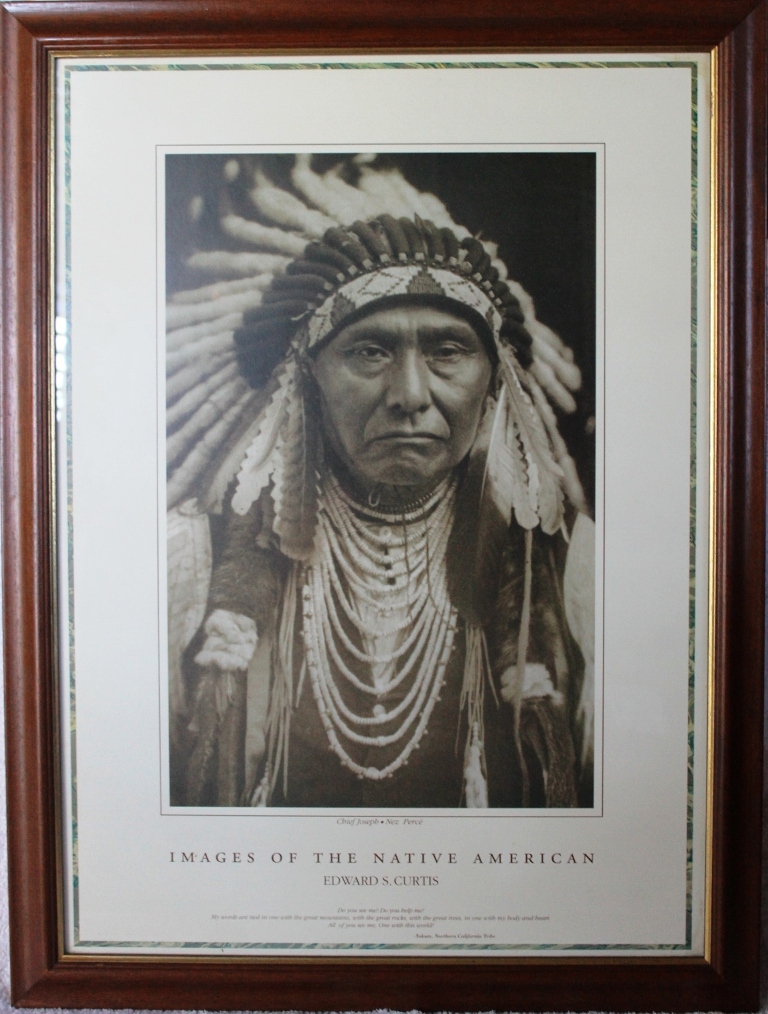
Hinmaton-Yalaktit - Chief Joseph - part of Pittwater Online's office.
A wall-mounted quote by Joseph in The American Adventure in the World Showcase pavilion of Walt Disney World's Epcot.
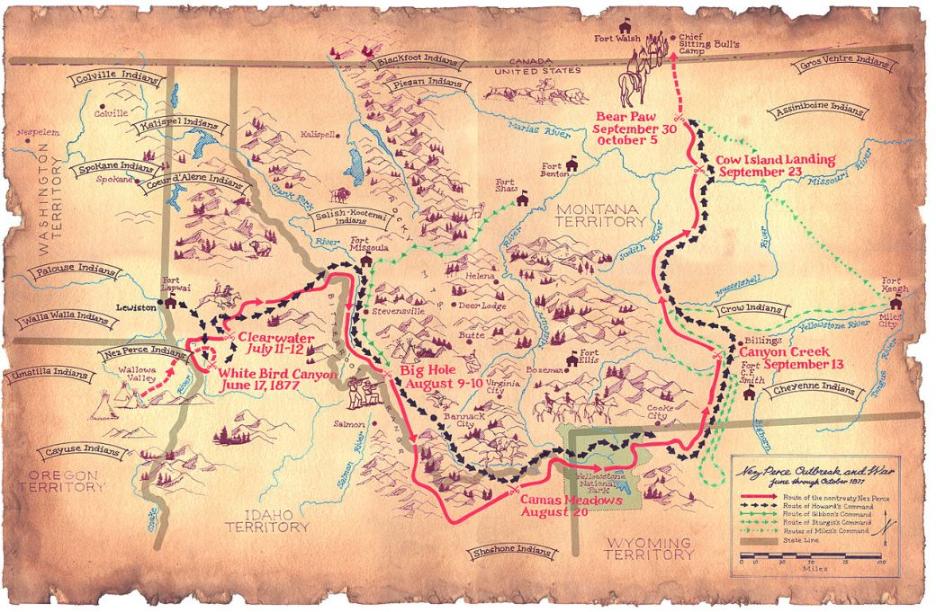
Flight of the Nez Perce - 1877 Map. For over three months, the Nez Perce outmaneuvered and battled their pursuers traveling 1,170 miles (1,880 km) across Oregon, Washington, Idaho, Wyoming, and Montana.
Native Americans by Edward Curtis
Slideshow collated by Scott Ewing
The North American Indian by Edward S. Curtis is one of the most significant and controversial representations of traditional American Indian culture ever produced. Issued in a limited edition from 1907-1930, the publication continues to exert a major influence on the image of Indians in popular culture. Curtis said he wanted to document "the old time Indian, his dress, his ceremonies, his life and manners." In over 2000 photogravure plates and narrative, Curtis portrayed the traditional customs and lifeways of eighty Indian tribes. The twenty volumes, each with an accompanying portfolio, are organized by tribes and culture areas encompassing the Great Plains, Great Basin, Plateau Region, Southwest, California, Pacific Northwest, and Alaska.
Researched and compiled by A J Guesdon, 2014.